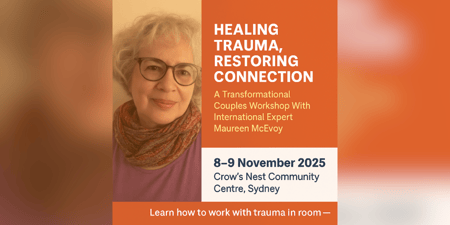Somatic Experiencing
Somatic experiencing practitioners near you
How can Somatic Experiencing nourish you?
According to Somatic Experiencing®, many people store trauma[1] in their body due to a shocking event or unresolved childhood experiences. This trauma can cause issues such as emotional distress and physical pain. Unlike other forms of psychotherapy, Somatic Experiencing® focuses on physical sensations as opposed to emotions or memories to assist release and regulation of the stress response.
Somatic Experiencing® therapists help participants gain low-level awareness of trauma (titration), dissipate arousal (discharge) and learn relaxation techniques such as breathing or visualisation to overcome the stress response called ‘freezing'.[2] By turning off a threat and releasing stored energy, a person may return to a relaxed, self-regulated reality.
Trauma specialist, Dr. Peter Levine, Ph.D.,[3] developed Somatic Experiencing® in the 1970s. He holds doctorate degrees in Medical Biophysics and in Psychology and has authored several books such as “Waking the Tiger: Healing Trauma”.[4]
The Somatic Experiencing® framework may be practiced by a range of healing professions. The USA-based Somatic Experiencing® Trauma Institute™[5] provides worldwide professional training, ensuring consistent courses via strict contractual obligations with local organisers. The intensive part-time training is spread over three years and involves classroom education, case consultations and practical training. Graduates are then qualified as a Somatic Experiencing® Practitioner.
Benefits of Somatic Experiencing
Somatic Experiencing® may be beneficial for those who have been impacted by trauma or sustained stress.[6] Examples of this may be abuse, accidents, birth trauma, conflict, illness, loss, natural disasters, neglect, and near death.
Two randomised controlled studies of patients undergoing Somatic Experiencing® showed positive outcomes[7] on symptoms of Post-Traumatic Stress Disorder (PTSD) as well as chronic pain associated with that event.[8] An additional 2016 study[9] suggested Somatic Experiencing® in conjunction with Play Therapy can assist with “both the prevention and occurrence of post-surgical, Toddler Trauma and resolution of childhood PTSD”.
What to expect from a Somatic Experiencing session
Somatic Experiencing® sessions[10] can be conducted while sitting, lying or standing. There are no set number of sessions and treatments can take one to two hours.
Without triggering or retraumatising you, a Somatic Experiencing® Practitioner will encourage exploration of uncomfortable sensations and underlying emotions. Unlike exposure therapy, the past trauma does not need to be discussed in detail.
The practitioner will encourage awareness of signs such as breathing, temperature, heaviness, tightness and dizziness. You may be guided to alternate (or) between feelings of discomfort and comfort. This encourages the awareness and release of pent up emotions while learning self-calming strategies.
You are likely to be encouraged to practice these awareness and stress-coping skills in everyday life. The use of Fitbits or smart watches may be suggested so that you can monitor your stress signs when not in a session. The intention of Somatic Experiencing® is to reinforce your inherent capacity to self-regulate so you can release trauma and relax.
As with any exercise or wellness program, please consult your medical professional before commencing Somatic Experiencing®.
If you have any concerns at all, also speak to your Somatic Experiencing® practitioner, who will be happy to address these and evaluate whether Somatic Experiencing® is a suitable treatment for you.
References
1. Payne P, Levine PA, Crane-Godreau MA. Somatic experiencing: using interoception and proprioception as core elements of trauma therapy. Frontiers in Psychology; 2015.
2. Shiver, shake, quiver, quake. The Optimist Daily; 2015.
3. Peter Levine, PhD. NICABM; [cited on 2024 Dec 3].
4. Levine PA , Frederick A. Waking the Tiger: Healing Trauma. Goodreads; 1997.
5. Home. Somatic Experiencing® International; [cited on 2024 Dec 3].
6. Home. Somatic Events Australia; [cited on 2024 Dec 3].
7. Brom D, Stokar Y, Lawi C, et al. Somatic Experiencing for Posttraumatic Stress Disorder: A Randomized Controlled Outcome Study. J Trauma Stress; 2017.
8. Andersen TE, Lahav Y, Ellegaard H, Manniche C. A randomized controlled trial of brief Somatic Experiencing for chronic low back pain and comorbid post-traumatic stress disorder symptoms. Eur J Psychotraumatol; 2017.
9. INTERNATIONAL JOURNAL OF NEUROPSYCHOTHERAPY. Somatic Experiencing® International; 2017.
10. Pedersen T. All About Somatic Therapy. PsychCentral; 2021.
Frequently asked questions
Somatic experiencing practitioners near you
Related articles
Categories
Browse somatic experiencing practitioners by locations
Explore somatic experiencing practitioners within Australia
Explore somatic experiencing practitioners within United States
Browse Somatic Experiencing services by locations
Explore somatic experiencing practitioners within Australia


